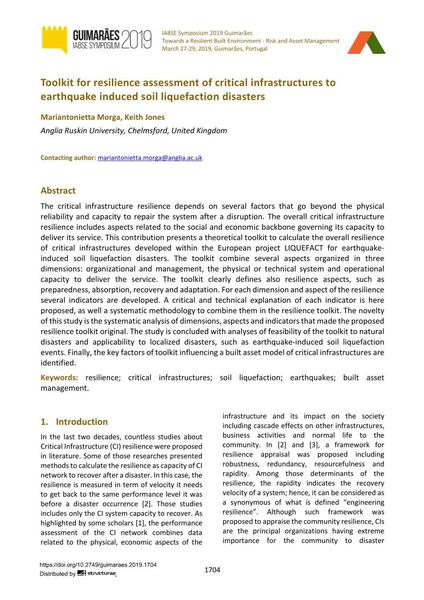Toolkit for resilience assessment of critical infrastructures to earthquake induced soil liquefaction disasters

|
|
|||||||||||
Bibliographic Details
| Author(s): |
Mariantonietta Morga
(Anglia Ruskin University, Chelmsford, United Kingdom)
Keith Jones (Anglia Ruskin University, Chelmsford, United Kingdom) |
||||
|---|---|---|---|---|---|
| Medium: | conference paper | ||||
| Language(s): | English | ||||
| Conference: | IABSE Symposium: Towards a Resilient Built Environment Risk and Asset Management, Guimarães, Portugal, 27-29 March 2019 | ||||
| Published in: | IABSE Symposium Guimarães 2019 | ||||
|
|||||
| Page(s): | 1704-1711 | ||||
| Total no. of pages: | 8 | ||||
| DOI: | 10.2749/guimaraes.2019.1704 | ||||
| Abstract: |
The critical infrastructure resilience depends on several factors that go beyond the physical reliability and capacity to repair the system after a disruption. The overall critical infrastructure resilience includes aspects related to the social and economic backbone governing its capacity to deliver its service. This contribution presents a theoretical toolkit to calculate the overall resilience of critical infrastructures developed within the European project LIQUEFACT for earthquake- induced soil liquefaction disasters. The toolkit combine several aspects organized in three dimensions: organizational and management, the physical or technical system and operational capacity to deliver the service. The toolkit clearly defines also resilience aspects, such as preparedness, absorption, recovery and adaptation. For each dimension and aspect of the resilience several indicators are developed. A critical and technical explanation of each indicator is here proposed, as well a systematic methodology to combine them in the resilience toolkit. The novelty of this study is the systematic analysis of dimensions, aspects and indicators that made the proposed resilience toolkit original. The study is concluded with analyses of feasibility of the toolkit to natural disasters and applicability to localized disasters, such as earthquake-induced soil liquefaction events. Finally, the key factors of toolkit influencing a built asset model of critical infrastructures are identified. |
||||
| Keywords: |
earthquakes resilience built asset management soil liquefaction critical infrastructures
|
||||
